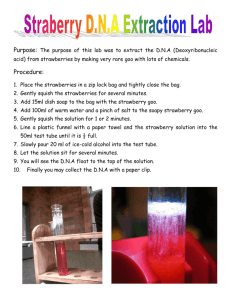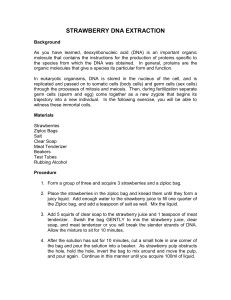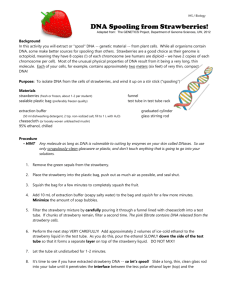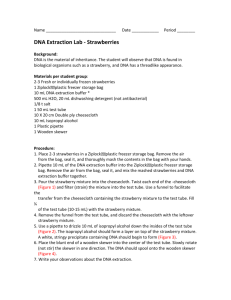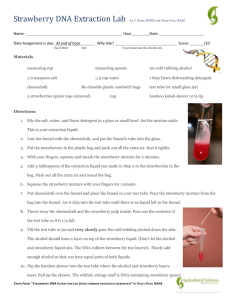Strawberry DNA
advertisement
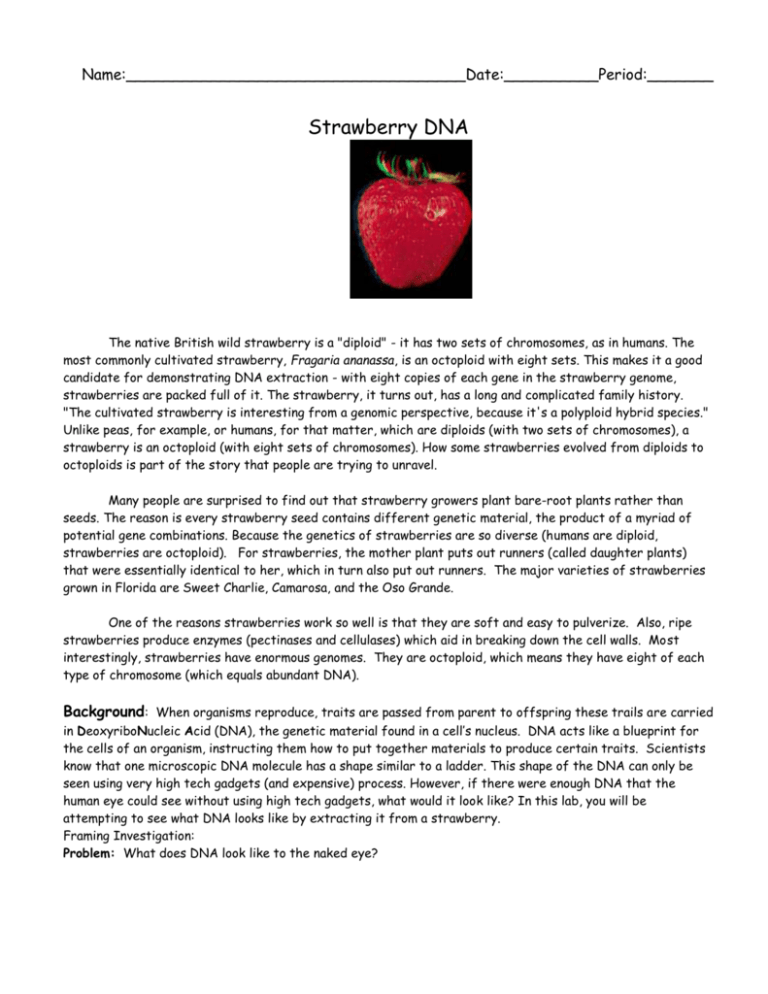
Name:____________________________________Date:__________Period:_______ Strawberry DNA The native British wild strawberry is a "diploid" - it has two sets of chromosomes, as in humans. The most commonly cultivated strawberry, Fragaria ananassa, is an octoploid with eight sets. This makes it a good candidate for demonstrating DNA extraction - with eight copies of each gene in the strawberry genome, strawberries are packed full of it. The strawberry, it turns out, has a long and complicated family history. "The cultivated strawberry is interesting from a genomic perspective, because it's a polyploid hybrid species." Unlike peas, for example, or humans, for that matter, which are diploids (with two sets of chromosomes), a strawberry is an octoploid (with eight sets of chromosomes). How some strawberries evolved from diploids to octoploids is part of the story that people are trying to unravel. Many people are surprised to find out that strawberry growers plant bare-root plants rather than seeds. The reason is every strawberry seed contains different genetic material, the product of a myriad of potential gene combinations. Because the genetics of strawberries are so diverse (humans are diploid, strawberries are octoploid). For strawberries, the mother plant puts out runners (called daughter plants) that were essentially identical to her, which in turn also put out runners. The major varieties of strawberries grown in Florida are Sweet Charlie, Camarosa, and the Oso Grande. One of the reasons strawberries work so well is that they are soft and easy to pulverize. Also, ripe strawberries produce enzymes (pectinases and cellulases) which aid in breaking down the cell walls. Most interestingly, strawberries have enormous genomes. They are octoploid, which means they have eight of each type of chromosome (which equals abundant DNA). Background: When organisms reproduce, traits are passed from parent to offspring these trails are carried in DeoxyriboNucleic Acid (DNA), the genetic material found in a cell’s nucleus. DNA acts like a blueprint for the cells of an organism, instructing them how to put together materials to produce certain traits. Scientists know that one microscopic DNA molecule has a shape similar to a ladder. This shape of the DNA can only be seen using very high tech gadgets (and expensive) process. However, if there were enough DNA that the human eye could see without using high tech gadgets, what would it look like? In this lab, you will be attempting to see what DNA looks like by extracting it from a strawberry. Framing Investigation: Problem: What does DNA look like to the naked eye? Prior Research: (Answer the following questions in complete sentences, using correct grammar and spelling) 1. Where is DNA located? 2. How difficult do you think it would be to remove DNA from a strawberry cell? Why. Designing the investigation Materials – Each pair will need the following materials Clear plastic vial with cap Styrofoam cup 1 - Zip lock bag 1 – bleached coffee filter 1 - Frozen strawberry 10 ml of Lysis buffer 30 ml of rubbing alcohol Procedure for Extraction 1. Collect materials. You will be working in pairs. 2. Place l strawberry into the zip lock bag and seal it tight. 3. Pulverize the fruit. Mush (massage the bag) it by hand for about 3 minutes. One student watch the time while the other “mashes” the fruit. DO NOT forget to make your observations. This should produce a homogenate of strawberries. This is a mechanical breakdown of the cell wall and structure. 4. Add 15 ml of the extraction buffer to the bag and reseal it. 5. Mush again for 2 minutes being careful not to create bubbles. Put data into data table. This is the chemical portion of the extraction procedure to lyse the cell membranes to release the DNA. 6. Put coffee filter over the top of a Styrofoam cup. 7. Carefully pour contents of the sandwich bag into the filter and set aside for about 10 minutes. When you are finished squeeze the filter to get the remainder of the extract or lysate. Make observations of what remains in the filter. 8. Throw filter away. 9. Add 30 ml of ice-cold alcohol into plastic vial. 10. Pour filtrate into a plastic vial – cap the vial and wait for DNA to start to precipitating out of the alcohol. The process begins almost immediately and the DNA will condense for the next few minutes. 11. Record observations of the appearance of the substance in the vial at one-minute intervals for 5 minutes in the data table. After 5 minutes are up, take the Popsicle stick and remove the white colored substance (DNA) at the top of the liquid in the vial. Make observations about it. Record in data table. 12. Clean up your area. Rinse out the Styrofoam cup, throw away the Ziploc bag and any remaining parts of the strawberry. All of your materials must be washed and returned to where you found them. DO NOT THROW away Popsicle sticks. You must wash the DNA off of the stick into the sink, and then dry the Popsicle stick and return it with other supplies. Data Table: Item Being observed Observation (you may draw pictures as well as write descriptions) Pulverized strawberry Pulverized Strawberry with Lysis buffer mixed in Coffee filter after straining strawberry Vial Observation 1 minute Vial observation 2 minutes Vial Observation 3 minute Vial Observation 4 minute Vial Observation 5 minute Observation of DNA on Popsicle stick Explanation The detergent in the shampoo helps to dissolve the phospholipid bilayers of the cell membrane and organelles. The salt helps keep the proteins in the extract layer so they aren’t precipitated with the DNA. DNA is not soluble in ethanol. When molecules are soluble, they are dispersed in the solution and are therefore not visible. When molecules are insoluble, they clump together and become visible. The colder the ethanol, the less soluble the DNA will be in it yielding more visible “clumping.” This is why it is important for the ethanol to be kept in a freezer or ice bath. Student Data Sheet: Answer the questions on the data sheet in complete sentences. 1. Did the DNA look like you thought it would? Why or why not? 2. What steps in the procedure contributed to the release of the DNA from the Strawberry plant cells? 3. Do you think the experiment would work using a banana? Why or why not? 4. Why do Strawberries yield high amounts of DNA? 5. Describe the appearance of the DNA.
